- Home
- Stephen E. Ambrose
Band of Brothers Page 8
Band of Brothers Read online
Page 8
Burt Christenson jumped right behind Winters. “I don’t think I did anything I had been trained to do, but suddenly I got a tremendous shock when my parachute opened.” His leg bag broke loose and “it was history.” He could hear a bell ringing in Ste. Mère-Eglise, and see a fire burning in town. Machine-gun bullets “are gaining on me. I climb high into my risers. Christ, I’m headed for that line of trees. I’m descending too rapidly.” As he passed over the trees, he pulled his legs up to avoid hitting them. “A moment of terror seized me. 70 ft. below and 20 ft. to my left, a German quad-mounted 20 mm antiaircraft gun is firing on the C-47s passing overhead.” Lucky enough for Christenson, the Germans’ line of fire was such that their backs were to him, and the noise was such that they never heard him hit, although he was only 40 yards or so away.
Christenson cut himself out of his chute, pulled his six-shot revolver, and crouched at the base of an apple tree. He stayed still, moving only his eyes.
“Suddenly I caught movement ten yards away, a silhouette of a helmeted man approaching on all fours. I reached for my cricket and clicked it once, click-clack. There was no response. The figure began to move toward me again.”
Christenson pointed his revolver at the man’s chest and click-clacked again. The man raised his hands. “For Christ sake, don’t shoot.” It was Pvt. Woodrow Robbins, Christenson’s assistant gunner on the machine-gun.
“You dumb shit, what the hell’s wrong with you? Why didn’t you use your cricket?” Christenson demanded in a fierce whisper.
“I lost the clicker part of the cricket.”
Slowly the adrenaline drained from Christenson’s brain, and the two men began backing away from the German position. They ran into Bill Randleman, who had a dead German at his feet. Randleman related that the moment he had gotten free of his chute he had fixed his bayonet. Suddenly a German came charging, his bayonet fixed. Randleman knocked the weapon aside, then impaled the German on his bayonet. “That Kraut picked the wrong guy to play bayonets with,” Christenson remarked.
· · ·
Lieutenant Welsh’s plane was at 250 feet, “at the most,” when he jumped. As he emerged from the C-47, another plane crashed immediately beneath him. He claimed that the blast from the explosion threw him up and to the side “and that saved my life.” His chute opened just in time to check his descent just enough to make the “thump” when he landed painful but not fatal.
Most of the men of Easy had a similar experience. Few of them were in the air long enough to orient themselves with any precision, although they could tell from the direction the planes were flying which was the way to the coast.
They landed to hell and gone. The tight pattern within the DZ near Ste. Marie-du-Mont that they had hoped for, indeed had counted on for quick assembly of the company, was so badly screwed up by the evasive action the pilots had taken when they hit the cloud bank that E Company men were scattered from Carentan to Ravenoville, a distance of 20 kilometers. The Pathfinders, Richard Wright and Carl Fenstermaker, came down in the Channel after their plane was hit (they were picked up by H.M.S. Tartar, transferred to Air Sea Rescue, and taken to England).
Pvt. Tom Burgess came down near Ste. Mère-Eglise. Like most of the paratroopers that night, he did not know where he was. Low-flying planes roared overhead, tracers chasing after them, the sky full of descending Americans, indistinct and unidentifiable figures dashing or creeping through the fields, machine-guns pop-pop-popping all around. After cutting himself out of his chute with his pocketknife, he used his cricket to identify himself to a lieutenant he did not know. Together they started working their way toward the beach, hugging the ubiquitous hedgerows. Other troopers joined them, some from the 82d (also badly scattered in the jump), some from different regiments of the 101st. They had occasional, brief firefights with German patrols.
The lieutenant made Burgess the lead scout. At first light, he came to a corner of the hedgerow he was following. A German soldier hiding in the junction of hedgerows rose up. Burgess didn’t see him. The German fired, downward. The bullet hit Burgess’s cheekbone, went through the right cheek, fractured it, tore away the hinge of the jaw, and came out the back of his neck. Blood squirted out his cheek, from the back of his neck, and from his ear. He nearly choked to death.
“I wanted to live,” Burgess recalled forty-five years later. “They had hammered into us that the main thing if you get hit is don’t get excited, the worst thing you can do is go nuts.” So he did his best to stay calm. The guys with him patched him up as best they could, got bandages over the wounds, and helped him into a nearby barn, where he collapsed into the hay. He passed out.
At midnight, a French farmer “came out to the barn and sat there and held my hand. He even kissed my hand.” He brought a bottle of wine. On the morning of June 7, the farmer fetched two medics and lent them a horse-drawn cart, which they used to take Burgess down to the beach. He was evacuated to England, then back to the States. He arrived in Boston on New Year’s Eve, 1944. He was on a strictly liquid diet until March 1945, when he took his first bite of solid food since his last meal at Uppottery, June 5, 1944.
· · ·
Private Gordon hit hard. He had no idea where he was, but he had a definite idea of what he was determined to do first — assemble his machine-gun. He tucked himself into a hedgerow and did the job. As he finished, “I noticed this figure coming, and I realized it was John Eubanks from the way he walked.” Shortly thereafter Forrest Guth joined them. Another figure loomed in the dark. “Challenge him,” Gordon said to Eubanks. Before Eubanks could do so, the man called out, “Flash.” Eubanks forgot the countersign (“Thunder”) and forgot that the clicker was an alternative identification option, and instead said, “Lightning.” The man lobbed a grenade in on the three E Company men. They scattered, it went off, fortunately no one was hurt, the soldier disappeared, which was probably good for the group, as he was clearly much too nervous to trust.
Gordon, Eubanks, and Guth started moving down a hedgerow toward the beach. They saw an American paratrooper run through the field, crouch, and jump into a drainage ditch (there was a three-quarters moon that night, and few clouds over the land, so visibility was fair). Gordon told the others to stay still, he would check it out. He crept to the ditch, where “I encountered these two eyeballs looking up at me and the muzzle of a pistol right in my face.”
“Gordon, is that you?” It was Sgt. Floyd Talbert. Now there were four. Together they continued creeping, crawling, moving toward the beach. A half-hour or so before first light, Guth heard what he was certain was the howling and whining of a convoy of 2½ ton G.I. trucks going past. How could that be? The seaborne invasion hadn’t even started, much less put truck convoys ashore. Some tremendous bursts coming from inland answered the question: the noise Guth heard came from the shells passing overhead, shells from the 16-inch naval guns on the battleships offshore.
The E Company foursome joined up with a group from the 502d that had just captured a German strong point in a large farm complex that dominated the crossroads north of the beach at Ravenoville. They spent the day defending the fortress from counterattacks. In the morning of D-Day plus one, they set out southward in search of their company.
· · ·
Jim Alley crashed into a wall behind a house, one of those French walls with broken glass imbedded in the top. He was cut and bleeding in several places. He backed into the corner of a garden and was in the process of cutting himself out of the harness when someone grabbed his arm. It was a young woman, standing in the bushes.
“Me American,” Alley whispered. “Go vay, go vay.” She went back into her house.
Alley found his leg pack, got his gear together (thirteen rounds of 60 mm mortar ammunition, four land mines, ammunition for his M-1, hand grenades, food, the base plate for the mortar and other stuff), climbed to the top of the wall, and drew machine-gun fire. It was about a foot low. He got covered with plaster before he could fall back into the garden.
He lay down to think about what to do. He ate one of his Hershey bars and decided to go out the front way. Before he could move, the young woman came out of the house, looked at him, and proceeded out the front gate. Alley figured, “This is it. I’ll make my stand here.” Soon she returned. A soldier stepped through the gate after her. “I had my gun on him and he had his on me.” They recognized each other; he was from the 505th.
“Where the hell am I?” Alley demanded. He was told, “Ste. Mère-Eglise.” He joined up with the 505th. At about daybreak he ran into Paul Rogers and Earl McClung from Easy. They spent the day, and the better part of the week that followed, fighting with the 505th.
All across the peninsula, throughout the night and into the day of D-Day, paratroopers were doing the same — fighting skirmishes, joining together in ad hoc units, defending positions, harassing the Germans, trying to link up with their units. This was exactly what they had been told to do. Their training and confidence thus overcame what could have been a disaster, and thereby turned the scattered drop from a negative into a plus. The Germans, hearing reports of action here, there, everywhere, grossly overestimated the number of troopers they were dealing with, and therefore acted in a confused and hesitant manner.
· · ·
Winters had come down on the edge of Ste. Mère-Eglise. He could see the big fire near the church, hear the church bell calling out the citizens to fight the fire. He could not find his leg bag. The only weapon he had was his bayonet, stuck into his boot. His first thought was to get away from the machine-gun and small arms fire in the church square. Just as he started off, a trooper landed close by. Winters helped him out of his chute, got a grenade from him, and said, “Let’s go back and find my leg bag.” The trooper hesitated. “Follow me,” Winters ordered and started off. A machine-gun opened up on them. “To hell with the bag,” Winters said. He set out to the north to bypass Ste. Mère-Eglise before turning east to the coast. In a few minutes, he saw some figures and used his cricket. He got a reassuring double click-clack from Sergeant Lipton.
Lipton had landed in a walled-in area behind the hôtel de ville (city hall) in Ste. Mère-Eglise, a block from the church. Like Winters, he had lost his weapon when he lost his leg bag. In his musette bag he had two grenades and a demolitions kit, plus his trench knife. He climbed over a gate and worked his way down the street, away from the church and the fire. At the edge of town there was a low, heavy concrete signpost with the name of the village on it. Lipton put his face up close to the letters and moved along them, reading them one by one, until he knew that the sign read “Ste. Mère-Eglise.” Paratroopers were coming down around him. Not wanting to get shot by a nervous American, when he saw two coming down close together, he ran right under them. When they hit the ground, before they could even think about shooting, Lipton was already talking to them. They were from the 82d Airborne, 10 kilometers away from where they were supposed to be. Sergeant Guarnere joined up, along with Don Malarkey, Joe Toye, and Popeye Wynn. A few minutes later, Lipton ran into Winters.
“I saw a road sign down there,” Lipton reported. “Ste. Mère-Eglise.”
“Good,” Winters answered. “I know where that is. I can take it from here.” He set out at the head of the group, objective Ste. Marie-du-Mont. They joined a bunch from the 502d. About 0300 hours they spotted a German patrol, four wagons coming down the road. They set up an ambush, and there Guarnere got his first revenge for his brother, as he blasted the lead wagons. The other two got away, but E Company took a few prisoners.
A German machine-gun opened fire on the group. When it did, the prisoners tried to jump the Americans. Guarnere shot them with his pistol. “No remorse,” he said when describing the incident forty-seven years later. “No pity. It was as easy as stepping on a bug.” After a pause, he added, “We are different people now than we were then.”
At about 0600 hours they ran into Capt. Jerre Gross of D Company and forty of his men. They joined forces to head toward Ste. Marie-du-Mont, some 8 kilometers southeast. In a few minutes they ran into the 2d Battalion staff with about forty more men. Winters found an M-1, then a revolver, belt, canteen, and lots of ammunition, “so I was feeling ready to fight — especially after I bummed some food from one of the boys.” Lipton found a carbine. The others armed themselves.
· · ·
As the Americans moved toward Ste. Marie-du-Mont, so did the commander of the German unit defending the area, Col. Frederick von der Heydte of the 6th Parachute Regiment. He was an experienced soldier, having been in the German Army since the mid-1920s and having led men in combat in Poland, France, Russia, Crete, and North Africa. Colonel von der Heydte was the senior German officer present, as the division commanders were in Rennes, on the Seine River, for a war game. He had one battalion in and around Ste. Mère-Eglise, another near Ste. Marie-du-Mont, the third in Carentan. All his platoons were standing too, some were trying to engage the Americans, but confusion caused by reports of landings here, there, seemingly everywhere had made concerted counterattacks impossible.
Colonel von der Heydte wanted to see for himself. He drove his motorcycle from Carentan to Ste. Marie-du-Mont, where he climbed to the top of the church steeple, 50 or 60 meters above the ground. There he had a magnificent view of Utah Beach.
What he saw quite took his breath away. “All along the beach,” he recalled in a 1991 interview, “were these small boats, hundreds of them, each disgorging thirty or forty armed men. Behind them were the warships, blasting away with their huge guns, more warships in one fleet than anyone had ever seen before.”
Around the church, in the little village and beyond in the green fields crisscrossed by hedgerows, all was quiet. The individual firefights of the night had tapered off with the coming of light. Von der Heydte could see neither American nor German units.
Climbing down from the steeple, the colonel drove his motorcycle a couple of kilometers north to Brécourt Manor, where the German artillery had a battery of four 105 mm cannon dug in and camouflaged. There were no artillery men around; evidently they had scattered in the night after the airborne landings began. Von der Heydte roared back to Carentan, where he ordered his 1st Battalion to occupy and hold Ste. Marie-du-Mont and Brécourt, and to find some artillerymen to get that battery working. It was perfectly placed to lob shells on the landing craft on Utah Beach, and to engage the warships out in the Channel.
· · ·
By this time, about 0700, E Company consisted of two light machine-guns, one bazooka (no ammunition), one 60 mm mortar, nine riflemen, and two officers. As the 2d Battalion moved into a group of houses in a tiny village called Le Grand-Chemin, just three kilometers or so short of Ste. Marie-du-Mont, it drew heavy fire from up front. The column stopped; Winters and his men sat down to rest. Ten or fifteen minutes later, battalion S-1 Lt. George Lavenson, formerly of E Company, came walking down the road. “Winters,” he said, “they want you up front.”
Captain Hester, S-3, and Lieutenant Nixon, S-2, both close friends of Winters, told him there was a four-gun battery of German 105 mm cannon a few hundred meters across some hedgerows and open fields, opposite a large French farmhouse called Brécourt Manor. Intelligence had not spotted the cannon, as they were dug into the hedgerow, connected by an extensive trench system, covered by brush and trees. There was a fifty-man platoon of infantry defending the position (part of Colonel von der Heydt’s 1st Battalion); the cannon had just gone into action, firing on Utah Beach, some 4 or 5 kilometers to the northeast.
The 2d Battalion was less than 100 men strong at that point. Lieutenant Colonel Strayer had responsibilities in all four directions from Le Grand-Chemin. He was trying to build his battalion up to somewhere near its full strength of 600 men, and to defend from counterattacks. He could only afford to send one company to attack the German battery. Hester told Winters to take care of that battery.
· · ·
It was 0830. Captain Sobel was about to get a little revenge on Hitler, the U.S. Army was about
to get a big payoff from its training and equipment investment, the American people were about to get their reward for having raised such fine young men. The company that Sobel and the Army and the country had brought into being and trained for this moment was going into action.
· · ·
Winters went to work instinctively and immediately. He told the men of E Company to drop all the equipment they were carrying except weapons, ammunition, and grenades. He explained that the attack would be a quick frontal assault supported by a base of fire from different positions as close to the guns as possible. He set up the two machine-guns to give covering fire as he moved the men forward to their jump-off positions.
The field in which the cannon were located was irregular in shape, with seven acute angles in the hedgerow surrounding it. This gave Winters an opportunity to hit the Germans from different directions.
Winters placed his machine-guns (manned by Pvts. John Plesha and Walter Hendrix on one gun, Cleveland Petty and Joe Liebgott on the other) along the hedge leading up to the objective, with instructions to lay down covering fire. As Winters crawled forward to the jump-off position, he spotted a German helmet — the man was moving down the trench, crouched over, with only his head above ground. Winters took aim with his M-1 and squeezed off two shots, killing the Jerry.
Winters told Lieutenant Compton to take Sergeants Guarnere and Malarkey, get over to the left, crawl through the open field, get as close to the first gun in the battery as possible, and throw grenades into the trench. He sent Sergeants Lipton and Ranney out along the hedge to the right, alongside a copse of trees, with orders to put a flanking fire into the enemy position.

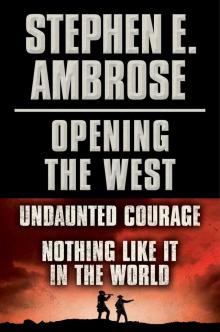 Undaunted Courage
Undaunted Courage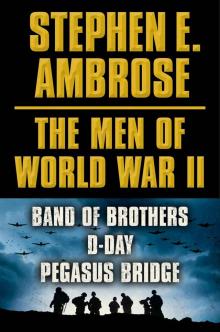 The Victors: Eisenhower and His Boys
The Victors: Eisenhower and His Boys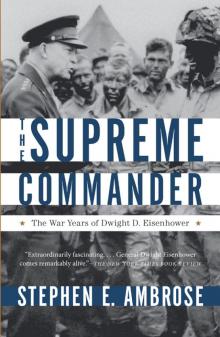 The Supreme Commander
The Supreme Commander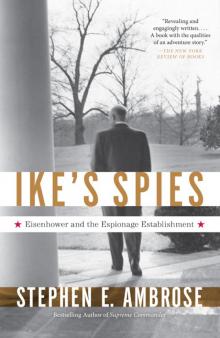 Ike's Spies: Eisenhower and the Espionage Establishment
Ike's Spies: Eisenhower and the Espionage Establishment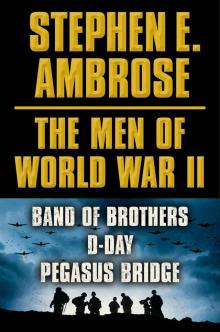 The Men of World War II
The Men of World War II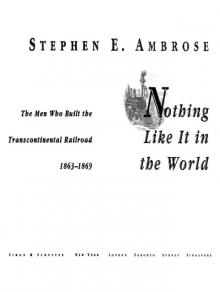 Nothing Like It in the World The Men Who Built the Transcontinental Railroad 1863-1869
Nothing Like It in the World The Men Who Built the Transcontinental Railroad 1863-1869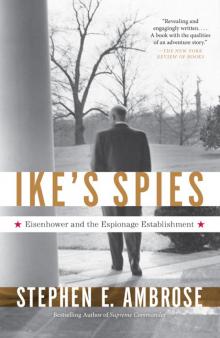 Ike's Spies
Ike's Spies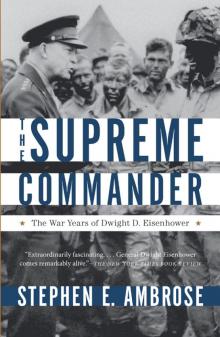 Supreme Commander
Supreme Commander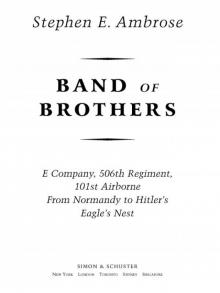 Band of Brothers
Band of Brothers